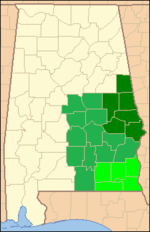Top Qs
Timeline
Chat
Perspective
United States District Court for the Middle District of Alabama
United States federal district court in Alabama From Wikipedia, the free encyclopedia
Remove ads
The United States District Court for the Middle District of Alabama (in case citations, M.D. Ala.) is a United States district court in the Eleventh Circuit (except for patent claims and claims against the U.S. government under the Tucker Act, which are appealed to the Federal Circuit).
The District was established on February 6, 1839.[1]
The United States Attorney's Office for the Middle District of Alabama represents the United States in civil and criminal litigation in the court. As of August 25, 2024[update] the acting United States attorney is Kevin P. Davidson.[2]
Remove ads
Organization of the court
The United States District Court for the Middle District of Alabama is one of three federal judicial districts in Alabama.[3] Court for the District is held at Dothan, Montgomery, and Opelika.
Eastern Division comprises the following counties: Chambers, Lee, Macon, Randolph, Russell, and Tallapoosa.
Northern Division comprises the following counties: Autauga, Barbour, Bullock, Butler, Chilton, Coosa, Covington, Crenshaw, Elmore, Lowndes, Montgomery, and Pike.
Southern Division comprises the following counties: Coffee, Dale, Geneva, Henry, and Houston.
Remove ads
Current judges
As of June 30, 2020[update]:
Remove ads
Vacancies and pending nominations
Former judges
- Recess appointment; formally nominated on January 23, 1860, confirmed by the United States Senate on January 30, 1860, and received commission on January 30, 1860.
- Recess appointment; formally nominated on January 5, 1864, confirmed by the Senate on January 20, 1864, and received commission on January 20, 1864.
- Recess appointment; formally nominated on December 5, 1901, confirmed by the Senate on December 17, 1901, and received commission the same day.
- Recess appointment; formally nominated on January 12, 1956, confirmed by the Senate on January 31, 1956, and received commission the same day.
Remove ads
Chief judges
Chief judges have administrative responsibilities with respect to their district court. Unlike the Supreme Court, where one justice is specifically nominated to be chief, the office of chief judge rotates among the district court judges. To be chief, a judge must have been in active service on the court for at least one year, be under the age of 65, and have not previously served as chief judge.
A vacancy is filled by the judge highest in seniority among the group of qualified judges. The chief judge serves for a term of seven years, or until age 70, whichever occurs first. The age restrictions are waived if no members of the court would otherwise be qualified for the position.
When the office was created in 1948, the chief judge was the longest-serving judge who had not elected to retire, on what has since 1958 been known as senior status, or declined to serve as chief judge. After August 6, 1959, judges could not become or remain chief after turning 70 years old. The current rules have been in operation since October 1, 1982.
Remove ads
Succession of seats
Remove ads
Court decisions
Browder v. Gayle (1956) – Court rules that bus segregation in Montgomery was unconstitutional under the Fourteenth Amendment. Decision upheld by U.S. Supreme Court six months later.
Gomillion v. Lightfoot (1958) – Court dismissed action, which was later affirmed by the Fifth Circuit. In 1960, the U.S. Supreme Court reversed the decision, finding that electoral districts drawn in Tuskegee, with the purpose of disenfranchising black voters, violated the Fifteenth Amendment.
Lee v. Macon County Board of Education (1963) – Court rules segregation in schooling was unconstitutional under the Fourteenth and Fifteenth Amendment. Decision upheld by U.S. Supreme Court.[4]
United States v. Alabama (1966) – Court rules poll tax violates the Fourteenth and Fifteenth Amendment. U.S. Supreme Court concurred three weeks later in an unrelated case, Harper v. Virginia Board of Elections.
Glassroth v. Moore (2002) – Court rules that a display of the Ten Commandments, erected by Alabama Chief Justice Roy Moore in the Alabama Judicial Building violated the Establishment Clause of the First Amendment.
Remove ads
U.S. attorneys
Remove ads
See also
References
External links
Wikiwand - on
Seamless Wikipedia browsing. On steroids.
Remove ads


